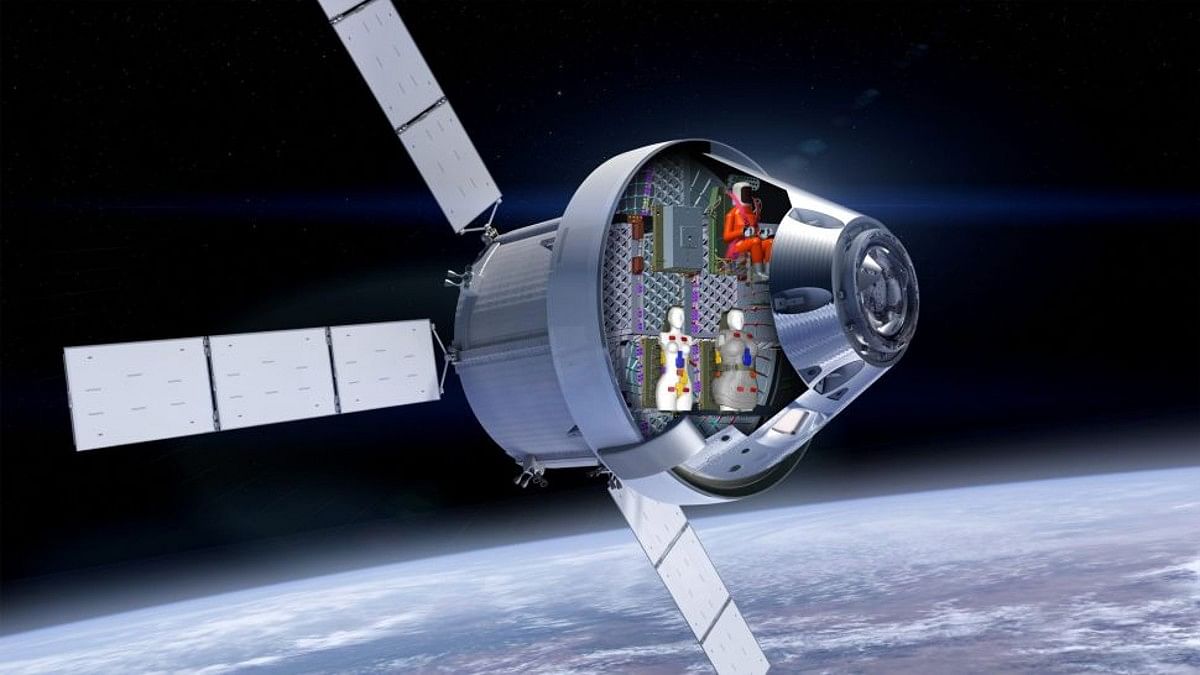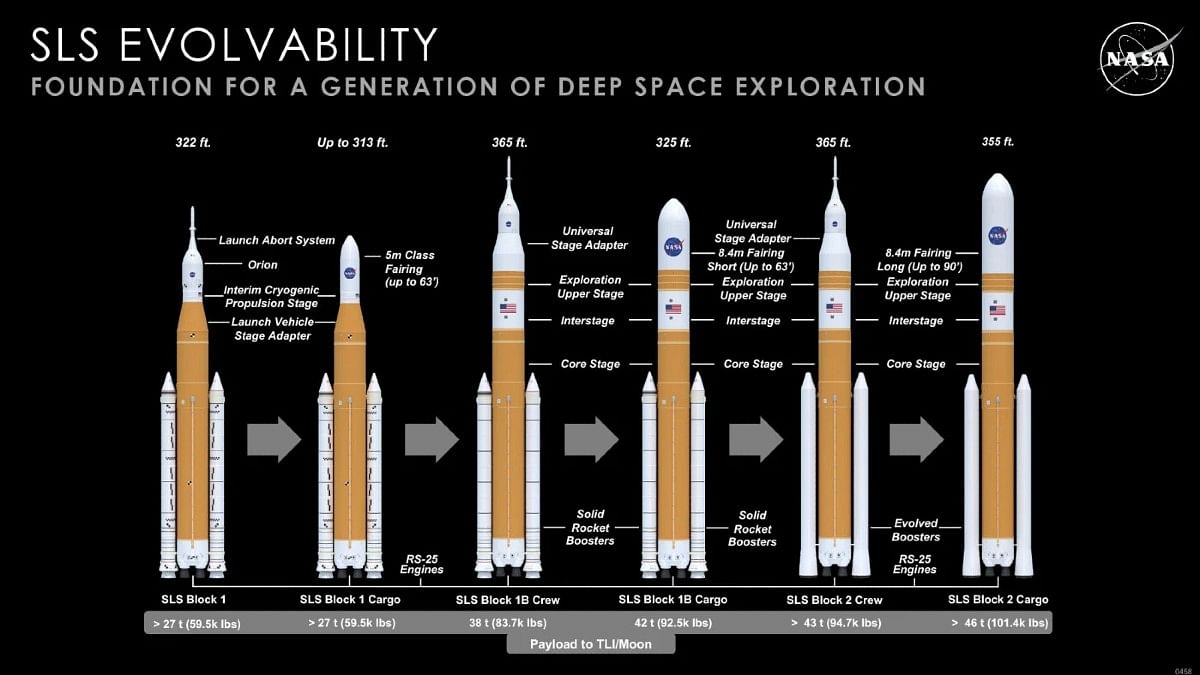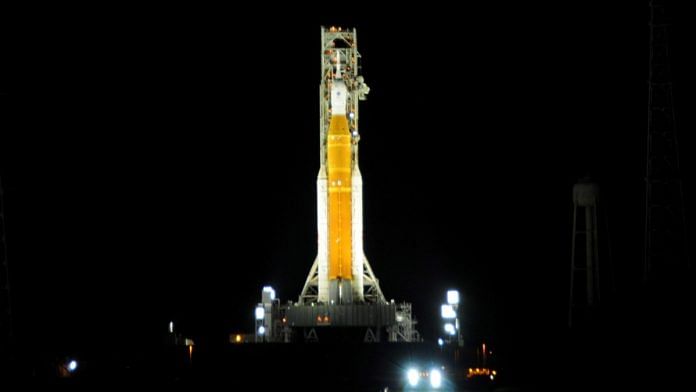Bengaluru: Nearly 50 years after humans last set foot on the lunar surface, America is once again sending spacecraft back to the Moon with the Artemis mission Monday.
The first flight of the mission, Artemis 1, is scheduled to launch from Kennedy Space Center in Florida on the SLS rocket in a two-hour window that opens at 12:33 UTC
(6:03 pm India time).
Artemis 1 is a 42-day mission that will not land on the Moon, but loop around it, dropping some satellites off in the process, before splashing back into the Pacific Ocean. It will be the first flight of both the extremely powerful SLS launch system as well as the complete Orion capsule, and the first robotic flight of the Artemis mission.
The mission is expected to be the first in a series of complex missions that aim to establish a human presence on the Moon. The mission objective for Artemis 1 is to demonstrate Orion’s systems in flight and perform a successful landing back to the Earth. The Orion capsule will return to the Earth on 10 October if there is no delay in its launch.
Currently, just two hours prior to launch, NASA is experiencing an issue with one of the engines while fuelling. A hydrogen leak was reported and fixed, but the engine isn’t seeing the desired flow rate. The agency is also investigating either frost formation or a potential crack on the ‘intertank flange’ which connects the liquid oxygen and hydrogen tanks.
More specifically a crack in a type of hardware called an "intertank flange." Now imagining Phoebe from Friends sitting in mission control and shouting, "there's something wrong with the left phalange!"
— Marina Koren (@marinakoren) August 29, 2022
”We will collaborate with commercial and international partners and establish the first long-term presence on the Moon. Then, we will use what we learn on and around the Moon to take the next giant leap: sending the first astronauts to Mars,” NASA had said on its official website about the larger goal of the Artemis programme.
Also Read: China is going to take over the Moon, NASA head says. But here’s why that won’t happen soon
Artemis and Apollo
The Apollo missions launched by America in the 1960s and 1970s carried the humans first to the surface of the Moon. The Artemis missions hope to carry the next group of Americans, including the first woman, to the Moon.
Artemis was the twin sister of Apollo in Greek mythology.
Artemis-1 is the first integrated and fully complete test mission of NASA’s deep space exploration infrastructure designed for future use: it will test the Orion spacecraft jointly built with the European Space Agency (ESA), the Space Launch System (SLS) rocket, as well as the complex and upgraded ground systems at the Kennedy Space Center in Florida.
During the flight, the Orion capsule will fly farther than any spacecraft carrying humans has flown. It will travel 64,000 km beyond the Moon, covering a total of 450,000 km over its full journey.
The rocket also carries a secondary payload of ten, sophisticated but economic cubesats. Cubesats are nano satellites that are built to standard dimensions of a 10 cm cube and weigh less than 1.3kg per unit.
These cubesats will be placed in outer space, between the Earth and the Moon, in a heliocentric orbit (around the sun). They will perform fly-bys of the Moon and send back detailed observations.
-
Morehead State University’s Lunar IceCube will observe the Moon for an hour to find locations of water, both on the ground and in air.
-
Arizona State University’s Lunar Polar Hydrogen Mapper (LunaH-Map) will calculate hydrogen concentrations in the entire lunar South Pole up to a meter below the surface.
-
Lockheed Martin’s LunIR will perform test manoeuvres and fly-bys with a cryogenic propulsion engine, and will map the Moon’s surface.
-
Japan Aerospace Exploration Agency’s cubesat OMOTENASHI (Outstanding MOon exploration TEchnologies demonstrated by NAno Semi-Hard Impactor) will demonstrate low cost lunar landing.
-
University of Tokyo’s EQUULEUS (EQUilibriUm Lunar-Earth point 6U Spacecraft) will study Earth’s plasmasphere, the part of the magnetosphere containing cool plasma or gas atoms with removed electrons.
-
Italian Space Agency’s ArgoMoon will collect data on SLS’s cryogenic engine and record images of the entire operation.
-
Southwest Research Institute’s CuSP (CubeSat for Solar Particles) will study the solar wind, the sun’s magnetic field, and general space weather.
-
NASA’s NEA Scout will deploy a solar sail and observe Near-Earth Asteroids and zero in on target rocks as it approaches them.
-
Another NASA payload, the BioSentinel cubesat, will carry yeast to study how radiation affects DNA.
-
Citizen scientist designers at Miles Space and Fluid & Reason submitted their winning entry to NASA’s CubeQuest Challenge. Their cubesat, Team Miles, will use innovative plasma iodine thrusters, which propel using low-frequency electromagnetic waves, and launch itself towards Mars.
Cultural and test payloads
While there are no humans on board, there will be three mannequins — Helga, Zohar, and Moonikin — that will measure radiation levels and vibrations for stress test during flight.

Lockheed Martin, in partnership with Amazon and Cisco, has on board the Orion a next-generation communication technology called Callisto, which utilises Alexa for its speech and communications programming.
NASA also has an informal tradition of carrying the Peanuts comic strip merchandise on flights, since the cartoon’s creator, Charles M. Schulz, created comic strips of Snoopy on the Moon. Since Apollo astronauts needed to “snoop around” the landing site, the lunar module came to be nicknamed Snoopy, and the command module, Charlie Brown. Artemis-1 will carry a Snoopy soft toy and a pen nib from Schulz’s studio.
There is also ESA’s famed character, Shaun the Sheep, as a toy on board. Engraved microchips containing the names of nearly 3.4 million people submitted through the agency website are also among the payloads.
SLS and Orion
The SLS has been one of NASA’s most-hyped pieces of equipment since work on it began in 2011, and it is set to supersede Saturn V, which launched the Apollo astronauts, as the most powerful rocket ever built.
Unlike Saturn V though, it is not a single piece of rocket, but functions more like a platform with six different configurations depending on launch needs, much like ISRO’s PSLV.

Despite being shorter in height than Saturn V, the super heavy-lift launch vehicle has more carrying capacity and increased thrust. After the boosters and core stage separate from the spacecraft after launch, the Orion capsule mounted on top will be propelled towards the Moon by a cryogenic propulsion stage, while climbing in orbit around the Earth and performing what is known as a trans-lunar injection.
The Orion is a partially reusable crewed spacecraft that will carry all the astronauts in the Artemis missions to the Moon. It was designed by Lockheed Martin and Airbus Defence & Space. Its service module, which provides power, propulsion, and life support, was designed by ESA.
(Edited by Tony Rai)
Also Read: ISRO-IISc team develops prototype of bacteria-infused bricks for Martian, lunar soil



